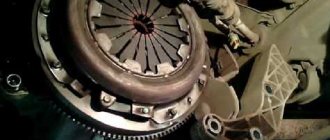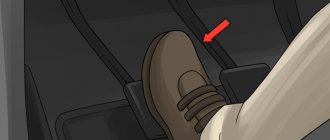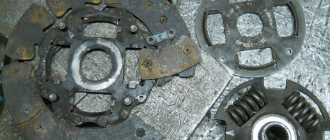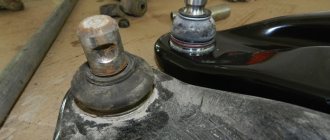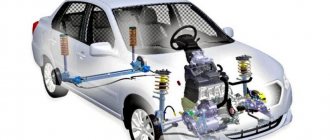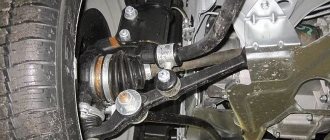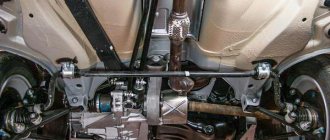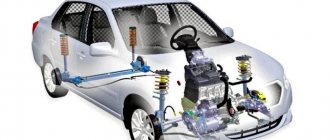The Lada Granta is a popular domestic car that has been successfully sold throughout the Russian Federation and even abroad for many years. Any car has its weak points, and over time, certain components of a complex design may break down. The operating conditions of the car are important. For example, when driving on bad roads or during periods of active use of reagents, car owners have to face a number of problems.
The clutch on a Lada Grant can fail at the most inconvenient moment. Therefore, it will be useful to find out how you can adjust this unit yourself, and when it needs to be completely replaced. Let's take a closer look.
Clutch box design "Lada-Grants"
On this car, this unit is no different from that installed in the Lada-Kalina. This is a mechanism consisting of a flywheel on which a special basket is attached. It must constantly press the disc with the friction linings. Thanks to this, torque begins to be transmitted to the transmission.
When we talk about a cable-type clutch on a Lada Grant, in this case it means that when the car owner presses the pedal, the cable that is connected to the clutch fork is tensioned, and special petals stop pressing the disc. Accordingly, the torque from the power unit is no longer transmitted to the gearbox.
There is only one clutch disc on the Lada Grant. This unit itself is a friction unit, equipped with a diaphragm-shaped spring. The clutch is combined with the gearbox in one housing.
How to check the release bearing on Kalina and how malfunctions manifest themselves (noisy or buzzing)
To understand whether your Kalina needs to replace the clutch, you must first react in time to signs of failure and diagnose the unit. Signs of a faulty Kalina release bearing:
- Noise or hum when pressing the pedal (damaged, insufficient lubrication or jammed);
- Difficulty pressing the pedal occurs when the coupling ear is broken, as well as the spring is deformed;
- These videos clearly show when the Kalina release bearing is faulty (noise, buzzing, knocking, creaking), as well as how to check the release bearing.
How to remove the release bearing from a Lada Kalina - location of the part and gearbox mounting diagram
As mentioned at the beginning of the article, to correctly replace the VP and dismantle it, you will need to remove the gearbox. Below is a photo of the transmission from below. To dismantle the manual transmission, you will need to disconnect all the components under the hood that are attached to it. Next, the wheel drives and front suspension elements are removed. Then the manual transmission is unscrewed from the “engine” and removed. Inside the “head” of the clutch housing is the release bearing itself.
What to pay attention to
There are certain signs that the clutch on the Lada Grant has failed and action needs to be taken. It is worth paying attention that if the car has just been purchased, the pedal will be pressed quite easily. If this requires great effort, then this is the first evidence that the clutch needs to be adjusted or replaced.
It is also worth paying attention to the appearance of extraneous squeaks at the moment when the driver presses the pedal. In addition, it should not twitch when the car owner does not touch it.
Most often, car enthusiasts are faced with the fact that the pedal travel becomes too tight. It is worth considering in more detail the reasons for this problem.
Why has the clutch pedal become stiff?
If the car is completely new, then the so-called drive wedge may have occurred. This is the easiest fault that you can adjust yourself. But if we are talking about an older car, then perhaps the problems are more serious and affect the entire unit.
Most often, such problems occur due to poor performance of the diaphragm spring. It is possible that the fork is jamming or the bearing being pressed out is jammed. Cable scuffing often occurs. The driven disk itself may also become jammed.
If the car is in use for a long time, then cracks may appear on the drive fork. You also need to understand that over many years of driving a car, a large amount of dirt could simply accumulate in this unit.
Types of faults
All types of clutch malfunctions installed on Grants are divided into the following groups:
- The clutch cannot be completely disengaged. The reasons for this type of breakdown lie in incomplete pedal travel, vibrations and possible jamming in the driven disk hub, warpage and distortion in the pressure disk, loose rivets and faulty friction linings. In addition, such a problem is often caused by a malfunction of the drive cable, a breakdown of the compensation mechanism, or disturbances in the mechanism that compensates for the wear of the driven disk linings.
- The clutch cannot be fully engaged. This breakdown can occur due to wear of the friction linings or due to their oiling. Other reasons for this malfunction include an oily surface of the flywheel and clutch basket and jamming (or damage) on the clutch drive.
- The clutch works with jerks. This violation is caused by oily friction linings, as well as an oily flywheel and clutch basket, a stuck drive and a damaged pressure plate surface.
- An increase in noise level when the clutch is engaged is caused by a malfunction of the damper springs.
- An increase in noise level during clutch disengagement is caused by a leak from the release bearing, as well as its damage or wear.
As a rule, if the clutch pedal fails and clicking and creaking sounds are detected during its operation, most often you just need to replace the clutch cable. Exactly how this procedure is performed will be discussed below.
Cable
To make sure that the clutch cable on the Lada Grant requires repair or replacement, it is enough to carry out a simple check. To do this, you need to depress the pedal and quickly release it. The lever should return to its original position quickly and without any vibration. If it jerks and does not go smoothly, then the problem is guaranteed to be in this part of the clutch.
More detailed diagnostics can also be performed. To do this, the cable must be disconnected. It is also a good idea to see how easily it moves across the shirt. Sometimes it is enough to add a little lubricant to it.
Fork
A tight pedal motion can also occur if this element needs to be lubricated. A characteristic sign of problems associated with the plug is that an unpleasant creaking noise is constantly heard during operation of the unit.
In order to solve the problem, you must first remove the entire air filter along with the housing. After this, the plastic bushing of the fork is carefully pryed off, and silicone grease is sprayed under it. You can also use the popular WD40.
Why is the pedal hard on the new clutch?
If a car owner purchased a new clutch kit for a Lada Granta, then he may encounter such a problem. The fact is that many people prefer to save money and purchase spare parts from Chinese manufacturers. Those, in turn, deliberately increase the stiffness of the leaf spring. Why is this being done? Everything is elementary. Such manipulations are carried out in order to increase the working life of the unit, which itself has worse characteristics compared to factory analogues.
Therefore, when replacing the clutch on a Lada Grant, it is worth purchasing higher quality parts. It is better to buy all elements from the manufacturer.
Preparation for repair
To remove and subsequently replace the clutch, prepare a set of tools consisting of:
- center punch;
- extension cord;
- funnels;
- heads (8, 10, 15, 17, 19 and 30 mm);
- high head (13 mm);
- heads Torx E12 and Torx E14;
- Phillips and flat screwdrivers;
- pliers;
- curved spanners (8 and 13 mm);
- straight spanners (17 and 19 mm);
- two adjustable stops;
- metal brush;
- ratchet wrench;
- caliper;
- stands;
- hammer;
- jack;
- balloon wrench;
- torque wrench;
- centering mandrel.
In addition, you will need to apply certain parts and consumables. So, you will need CV joint-4 lubricant, a guide pin M12×1.25 mm, transmission oil, wood blocks, a technical container, a hose, rags and the clutch itself.
Cost of a new node
If we talk about how much a clutch for a Lada Granta costs, then it all depends on the generation of the car, modification and other parameters. For example, if we are talking about a car produced between 2011 and 2018. with an engine capacity of 1.6 liters, a complete set can cost up to 35,000 rubles. But it is not always necessary to replace the entire assembly.
For example, a kit without a release bearing will cost about 5,800 rubles. Therefore, the price of a clutch for a Lada Granta may fluctuate.
Replacing the release bearing Kalina 2, 1118, Cross, Sport
To make a replacement you will need to put your car on a pit or a lift. Repairs are also possible if you have reliable supports and a jack. It is worth noting that without a pit or lift, the replacement method without removing the box, which is described at the end of the article, is suitable.
How to remove the gearbox and release bearing on Kalina 2 (1.4-1.6 8kl) with your own hands
Replacing the release bearing on a Lada Kalina begins with dismantling the gearbox; this process is described in detail in step-by-step instructions with photos/videos. Perform the operations in order.
- Open the hood of the car and immediately remove the battery.
- Next, remove the air filter by unscrewing the clamp and disconnecting the fastenings to the body.
- The clutch cable is located behind the battery; you need to unscrew the nut and disconnect the cable from the fastener.
- Now disconnect the plug of the speed sensor wire, it is located behind the “engine”, in the area of the pipes.
- Next, find the upper bolts securing the gearbox to the engine and unscrew them.
- The last operations on top of the gearbox are unscrewing the starter and its terminals, as well as disconnecting the clutch cable and electrical wiring.
- Remove the front wheels and tighten the hub nuts. We disconnect the protection (mud flaps) under the wing.
- Immediately disconnect the terminal of the reversing lights wire.
- Nearby there is a suspension beam, first twist the rear nut with a 24mm wrench.
- Now we move on to the ball joints, loosen the nuts and remove them on both sides.
- On the same side of the manual transmission we find the oil drain plug, unscrew it and drain it into any container.
- Between the manual transmission and the engine there is a clutch protective cover. To remove it, unscrew the nuts around the perimeter.
- Let's move on to dismantling the gearshift mechanism. First, unscrew the two bolts and remove the cover.
- Then unscrew the screw that secures the linkage connection.
- The next step is to remove the wheel drive shafts from the gearbox on both sides.
- Let's return to the suspension. On the manual transmission side, it is necessary to unscrew the bolt securing the lever, and also disconnect the extension.
- Next, to remove the gearbox and replace the release bearing of the VAZ Kalina, unscrew the lower bolts securing the gearbox to the engine, as well as the front cushion. Before doing this, be sure to install a support under the engine.
- As a result, the housing of the high-speed unit (MKPP-2181) will be completely disconnected from the mating units, and it can be dismantled. First, use a sharp, wide screwdriver to separate the assembly from the engine.
- Then we manually dismantle the assembly. It is advisable to use a special telescopic stand or ask a partner for help, since the gearbox is not light. After removal, we proceed to replacing the release bearing on the Lada Kalina with our own hands.
Features of correct adjustment of the unit
Quite often, clutch-related problems are solved by standard adjustments. However, such measures must be carried out based on the recommendations of specialists and experienced car owners. First of all, you need to turn off the engine. After this, just press the pedal several times and listen to the sounds. If no grinding or creaking is heard, then the adjustment continues.
If the Lada-Granta clutch pedal gets stuck or it moves jerkily, then its position needs to be adjusted. First of all, you need to completely squeeze it out with your hand. It is better not to use your foot, as in this case it will be much more difficult to feel minor jamming or, conversely, jerking at the moment when the lever returns to its original position.
If you manage to find out that the pedal twitches a little, then you need to arm yourself with a ruler and determine the distance from the floor to the pedal, or rather, the part that protrudes outward. After this, while continuing to hold the measuring device, the car owner must press the lever and wait until it returns to the same position. If the values on the ruler diverge or the distance is more than 14.5 cm, then in this case you need to make adjustments. It is worth noting that the full pedal travel should not be more than 146 mm. The cable guide cannot move in relation to the fork lever by more than 2.7 cm.
Are problems with gearbox operation always associated with an unadjusted clutch?
Mechanical transmission problems do not always indicate a clutch that needs to be adjusted. If the clutch seems to be at fault, check the list above. We will also look at other problems with the manual transmission. Frequent malfunctions are:
- Gearbox noise. In neutral, this happens when the oil in the box is reduced or contaminated or the bearings wear out. In transmission, the problem may be in the synchronizer, licked teeth and dead bearings. When changing gears, the problem may be an unadjusted clutch, bearings, synchronizer, misalignment of the clutch housing and crankshaft, as well as deformed clutch forks and gearbox.
- Vibrations. Typical for internal combustion engines with disrupted operation in neutral or when fastenings are destroyed (including self-unscrewing of bolts).
- Leaking oil. The reason is most often in oil seals, gaskets, excess oil level or deformation of the transmission itself.
- The gear shifts with difficulty or does not shift at all. The problem here can also be in the clutch, as well as in other factors - contamination, lack of oil, wear of couplings, springs, gears.
- The transmission turns off by itself. There are many reasons - synchronizers, grooves, springs, spontaneous loosening of bolts and others.
If you suspect clutching, take a closer look at the problem. It is far from certain that it is exactly to blame.
How long a gearbox will last depends directly on how you use the car. And the comfort, safety and controllability of your car depend on the service life of the gearbox.
If you do not want to repair the Lada Granta gearbox, follow a number of simple recommendations:
- With a manual transmission, one of the main operating factors is shifting gears with the clutch pedal fully depressed. You cannot change gears when it is not completely turned off. This leads to accelerated licking of the gear teeth. You need to choose a gear that matches your speed. It is best to move in fourth gear - it is direct and uses a minimum of gears. Accordingly, their wear is reduced. Speed range – 70-100 km/h.
- In winter, you should not leave the car in gear for a long time. This is unsafe and damages the transmission. After you start the engine, even if the car is in neutral, it may jerk.
- Lubrication of all components also has an effect. Periodically check the gearbox housing for oil leaks. They usually appear near the oil filler neck. Change your oil on time. The approximate replacement period is 50-70 thousand kilometers. Do not mix oils of different brands, as this may cause increased wear of all rubbing parts.
Features of clutch cable adjustment
First of all, you need to pull out the tip of the cable in accordance with the direction of its movement. It is also necessary to take into account the spring, which creates a certain force. After pulling the cable, you need to fix it and measure the distance from the clutch fork lever to the plastic wiring, or rather, its front edge. This figure should be no more than 27 mm. In this case, the ruler is not very convenient to use, since there is too little space under the hood. Therefore, the easiest way is to first measure 2.7 cm on a piece of wire.
Review of Manufacturer Prices
| Manufacturer article number | Price, rub.) | Resource (Thousand km) |
| Set of wheels LADA 2190-316010001 | From 3100 | 85 — 105 |
| —/— 2190-31601000 | —/— | —/— |
| —/— 302050901 | —/— | —/— |
| —/— 302052223 | —/— | —/— |
| —/— 302052307 | —/— | —/— |
| LADA 21810160118001 clutch | From 650 | 80 |
| LADA 21090160119000 input shaft guide | From 750 | 75 — 80 |
| LADA 21010160121500 fork support | From 150 | 75 – 95 |
| LADA 21810160120001 plug | From 800 | 85 – 95 |
| Connecting spring fork and clutch 21010160118800 | From 350 | 85 — 95 |
How to replace the cable yourself
In this case, no serious manipulations from the car owner will be required. First of all, you need to sit in the car and unscrew the nut under the pedal. She is responsible for attaching the cable itself to the main unit. After this you need:
- Remove the braid stopper from the pin.
- Armed with pliers, remove the locking bracket itself.
- Pull out the lever shaft.
- Remove the pedal bracket spring.
- Using pliers, pull out the tip stop.
- Release the pedal.
- Remove the cable sheath seals.
At the next stage, you need to pull the tip of the cable towards you and carefully pull it out of the groove. After this, the wiring of the tip and guide sleeve is dismantled. At the final stage, the cable is easily removed by passing through a hole located between the car interior itself and the engine compartment.
Before installing a new element, it is recommended to lubricate it with machine oil. Install the cable in the reverse order.
Operating principle
The classic dry clutch design used on passenger cars is permanently closed. The design of such a unit includes a basket with a drive disk, which is bolted to the flywheel. Between them there is a driven disk mounted on the splines of the gearbox input shaft. Due to a powerful diaphragm spring, the driven disk constantly presses the drive disk against the flywheel, which is why this circuit is called closed.
The task of the release bearing is to open the flow. The driver, pressing the clutch pedal, uses a drive to move the bearing along a guide sleeve mounted on the input shaft towards the basket. Due to the force of the driver's foot, this bearing presses on the diaphragm, resulting in the movement of the drive disk along the guides inside the basket. It moves away and releases the driven disk - the transmission of rotation is interrupted. After releasing the pedal, the bearing moves towards the gearbox, and the spring returns the drive disk to its place - the flow resumes.
Reviews from car owners
If you look at the opinions of car owners about this component of the car, many note that it quite often creates problems. For example, some have to deal with tight pedal movement or the appearance of unpleasant crunching and clicking noises.
However, few people have to buy a complete clutch kit. Often a specific detail is enough. Therefore, most often it is enough to install a new cable or lubricate the jacket. Accordingly, even if this unit fails, repairs will not be as expensive as it might seem.
In general, car owners are satisfied with this car. It is inexpensive and does not require special care. If you do not use it in extreme conditions, then there should be no problems. It also performs well on difficult roads. Many note that modern foreign cars at the same cost have much worse characteristics. But the opinions of car owners may be divided. Some people are not ready to exchange their Lada for anything, while others are happy to switch to another car.


